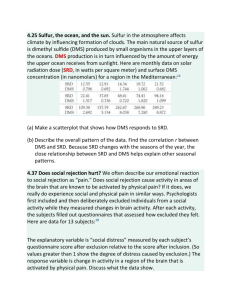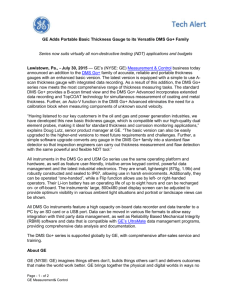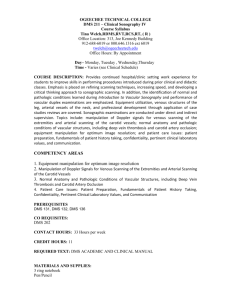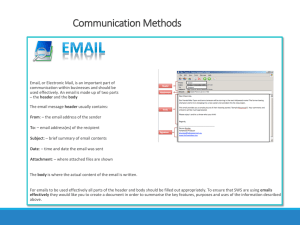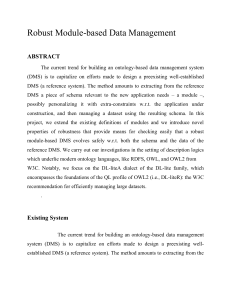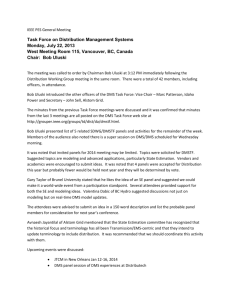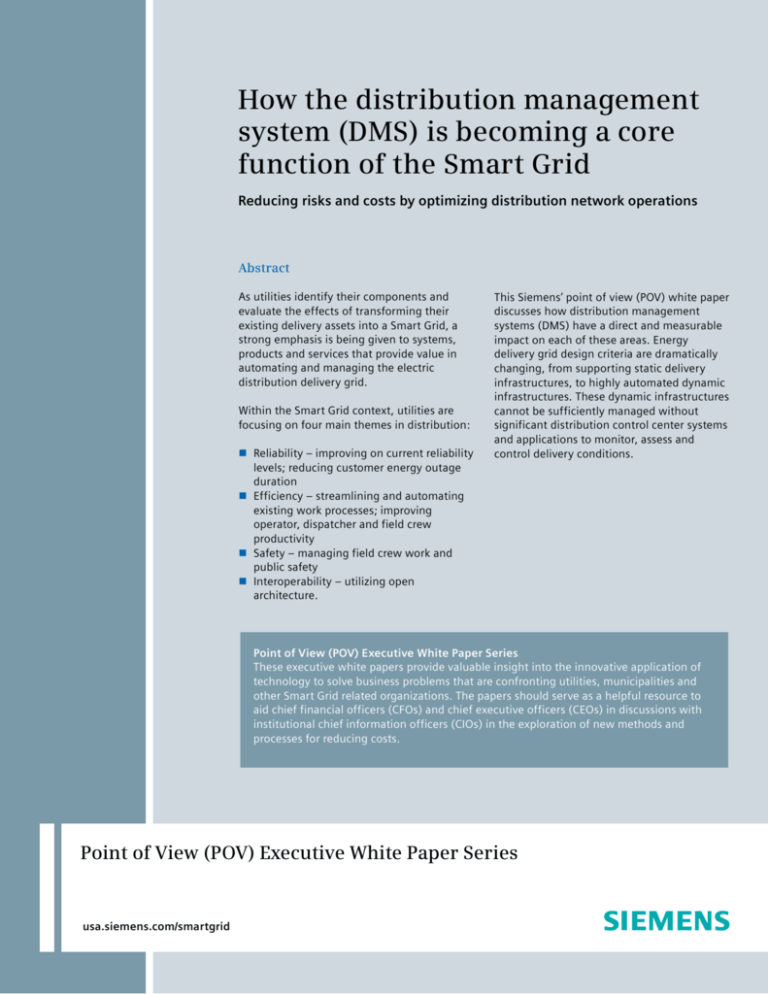
How the distribution management
system (DMS) is becoming a core
function of the Smart Grid
Reducing risks and costs by optimizing distribution network operations
Abstract
As utilities identify their components and
evaluate the effects of transforming their
existing delivery assets into a Smart Grid, a
strong emphasis is being given to systems,
products and services that provide value in
automating and managing the electric
distribution delivery grid.
Within the Smart Grid context, utilities are
focusing on four main themes in distribution:
n Reliability – improving on current reliability
levels; reducing customer energy outage
duration
n Efficiency – streamlining and automating
existing work processes; improving
operator, dispatcher and field crew
productivity
n Safety – managing field crew work and
public safety
n Interoperability – utilizing open
architecture.
This Siemens’ point of view (POV) white paper
discusses how distribution management
systems (DMS) have a direct and measurable
impact on each of these areas. Energy
delivery grid design criteria are dramatically
changing, from supporting static delivery
infrastructures, to highly automated dynamic
infrastructures. These dynamic infrastructures
cannot be sufficiently managed without
significant distribution control center systems
and applications to monitor, assess and
control delivery conditions.
Point of View (POV) Executive White Paper Series
These executive white papers provide valuable insight into the innovative application of
technology to solve business problems that are confronting utilities, municipalities and
other Smart Grid related organizations. The papers should serve as a helpful resource to
aid chief financial officers (CFOs) and chief executive officers (CEOs) in discussions with
institutional chief information officers (CIOs) in the exploration of new methods and
processes for reducing costs.
Point of View (POV) Executive White Paper Series
usa.siemens.com/smartgrid
Executive summary
DMS enables an opportunity
unlike any since the energy
delivery grid was originally
constructed.
DMS establishes a total
solution for power delivery
to consumers.
Utilities are increasingly
selecting vendors that can
provide larger contiguous
portions of a DMS solution.
We are in the midst of a paradigm shift in electrical infrastructure design and
operation. The opportunity is unlike any since the energy delivery grid was
originally constructed. The distribution management system (DMS) is a
fundamental component to enable this transition.
DMS – an integral part of the Smart Grid
DMS sits firmly in the middle of Smart Grid transition requirements, and
provides the basis from which to model operation and direct field activities in a
safe and efficient manner. It also serves as an operations platform, automating
tasks and filtering information for the operator. For a utility, it is the strategic
system that will enable management of a Smart Grid and will leverage its
benefits.
Implementing a DMS solution requires the integration of many different
elements – field equipment, communications, control centers and supporting
systems within the utility enterprise. This establishes a total solution for the
utility to achieve its business objectives in the reliable delivery of power to its
consumers.
In most cases, different vendors supply different pieces of a total solution, with
the utility serving as an integrator or employing an integrator to manage the
implementation.
Once a DMS is delivered,
utilities are looking for
follow-through.
DMS as part of a comprehensive strategy
With the acceptance of the need for Smart Grid roadmaps and transition plans,
utilities are increasingly selecting vendors that can provide larger contiguous
portions of a DMS solution to reduce their risk and ensure successful
implementations.
Ultimately, utilities are looking for total solution providers that will take
responsibility for the complete solution implementation. Their desire is that
these vendors also have a meaningful product component within the solution to
ensure access to focused subject matter expertise, product and market segment
commitment. This is a response to opportunist integrators who have won initial
implementation projects, but failed to provide specialized expertise and have
not retained market segment focus.
Distribution management system challenges and trends
2
DMS supports the day-today management of the
distribution network.
The DMS is an integrated systems solution supporting the day-to-day
management of the distribution network, related construction and maintenance
efforts, and proactively guides operators when the system is needed most –
during storms and related restoration activities.
DMS is rapidly becoming an
essential element for
delivery reliability while
reducing complexity and
automating related work
processes.
As the utility workforce ages and utilities come under greater pressure to more
fully utilize existing equipment, DMS is rapidly becoming an essential element in
maintaining and improving delivery reliability while reducing complexity and
automating related work processes. The recent acceleration in distribution
automation, substation automation and automated metering initiatives in the
industry has created additional impetus to establish DMS as a solid foundation
to leverage these aspects of the emerging Smart Grid.
These systems are usually either not integrated or have very light interfaces –
requiring distribution operators to deal with multiple systems, applications and
user interfaces.
Background
A DMS can help improve control room operations and key performance
indicators. As the utilization of electrical energy has increased, its optimal usage
and reliability has become important. Real-time network view and dynamic
decisions have become instrumental for optimizing resources and managing
demands, thus creating the need for a DMS that can handle increasingly
complex work flows.
DMS overview – taking OMS to the next level
A DMS is a collection of applications that can monitor and control the entire
distribution network efficiently and reliably. It acts as a decision support system
to assist the control room and field operating personnel with the monitoring and
control of the electric distribution system. Improving the reliability and quality of
service in terms of reducing outages, minimizing outage time, maintaining
acceptable frequency and voltage levels are the key deliverables of a DMS.
Increased energy usage has
created the need for a DMS
that can handle increasing
work flows.
Improving reliability and
quality of service are the
key deliverables of a DMS.
Most distribution utilities have been comprehensively using IT solutions through
their outage management systems (OMS). A DMS takes an OMS to the next level
by automating complete sequences and providing an end-to-end, integrated
view of the entire distribution system. It accesses real-time data and provides all
information on a single console at the control center in an integrated manner.
Significantly improved operator efficiency
A DMS provides an efficient visual interactive work environment that integrates
all information sources within a common real-time workspace. It reduces the
number of systems on the operator’s desk, predicts operating issues, provides
greater clarity in emergency situations and improves operator response time.
DMS also supports management of the system with less experienced users and
promotes improved staff retention.
The clarity provided by DMS
greatly improves operator
efficiency.
Standards-based Integration
Due to the addition of a new consumer, a new transmission line or replacement
of equipment, the distribution system changes daily. If the different functional
modules are operating in a non-standard environment, the engineering effort
becomes unmanageable.
A standards-based integration eases integration with other functional modules
and also improves operational performance. It ensures that a utility can be in a
vendor-neutral environment for future expansions, which in turn means that the
utility can easily add new functional modules on top of existing functionality.
A standards-based
integration eases the
integration with other
functional modules and
also improves operational
performance.
3
Case study – Oncor
Customers have come to consider electricity as an almost inalienable right. They
expect to have it and to have it all the time. In households and businesses alike,
power outages quickly escalate from inconvenient to unacceptable.
Siemens helped Oncor to
deploy the industry’s first
fully integrated distribution
operations environment for
the power grid.
An interactive, digitized, intelligent electric grid is becoming reality at Oncor, the
largest distribution and transmission company in Texas. Oncor’s Smart Grid
connects power providers and customers to improve both reliability in a
deregulated market and service across the Oncor system. Oncor is taking its
already high-level distribution management and customer service skills to a new
level by deploying the industry’s first fully-integrated distribution operations
environment for the power grid.
Siemens worked with Oncor and other stakeholders to provide an off-the-shelf,
fully integrated DMS solution consisting of a consolidated user interface running
on a common operating platform that allows for system maintenance and keeps
upgrade costs under control. Operational challenges were limiting Oncor’s
capabilities. Operators had to toggle between keyboards, windows and
applications to access necessary data, consolidate disparate information
manually and decide what actions to take. Although the various applications
were functional and valuable, the environment was complicated, and the
process needed improvement to cope with existing and anticipated operations
requirements.
The DMS allows Oncor to
better prevent outages and
streamline the operator
experience.
It became clear to Oncor that to gain the efficiencies they required, the
operators’ tasks would need to be automated end-to-end by consolidating the
user interfaces of the many applications necessary into a single operator
environment. Adding the DMS framework to the infrastructure simplifies the
operator’s job by improving analysis and decision-making capabilities, allowing
Oncor to better prevent outages and other network interruptions, respond more
quickly and efficiently when they occur and reduce the average outage minutes.
DMS impacts on assets and reliability
Operators rely on DMS to
maintain assets in top form.
DMS for any utility is a mission-critical tool. It is the tool that operators use for
command control of valued assets, optimize the life or output of those assets
and to maintain the highest degree of reliability for their customers.
DMS promotes system
integration.
A DMS solution creates the context to tightly integrate tools and systems
addressing different aspects of the distribution operator’s and/or dispatcher’s
work tasks, including but not restricted to:
n Outage management system (OMS) – provides the ability to view the
current connectivity of the distribution feeders and safely manage day-to-day
and emergency restoration work.
n Mobile work force management (MWFM) – provides the ability for work
crews to communicate electronically with the OMS directly from the field,
reducing delays in performing tasks and improving safety.
n Distribution network analysis (DNA) – provides equipment loading and
complex voltage calculations to help the operators understand the voltage
and loading of the distribution feeders and individual equipment at any point
in time. In particular, it can locate faults and provide optimum switching
guidance for operators in the field. It also provides a variety of operationsoptimization tools to offload the operations staff and improve efficiency.
n Distribution supervisory control and data acquisition (D-SCADA) – as
communication and distribution automation technology is being deployed, a
scalable and flexible SCADA provides real-time telemetry information to keep
the operating model as close as possible to the real conditions in the field, as
well as remote fast switching to improve reliability and reduce operational
costs (fuel, labor, etc.).
4
To achieve maximum efficiency and take full advantage of the features of the
different components, these systems are tightly integrated to automate the
user’s workflow.
For systems to work
efficiently, integration
is key.
Spectrum Power™ DMS
Today’s distribution grid operation is mainly characterized by manual procedures
relying on the experience of an aging work force. Using Siemens’ Spectrum
Power DMS enables a smart, self-healing grid by providing the following
improvements:
Spectrum Power DMS
enables a smart, selfhealing grid.
n Reduction of outage occurrences and durations by applying advanced fault
location and network reconfiguration algorithms
n Minimization of losses through improved monitoring
n Optimization of assets by management of demand and distributed generation
n Reduction of maintenance costs by online condition monitoring.
The smart management of electric distribution grids is one of the key success
factors to reach ambitious Smart Grid goals.
With Spectrum Power
From
To
n No monitoring,
control and
automation
n Automation of
distribution
substations
n No communication
n Communication in
distribution metworks
n No auxillary power
supply and motoroperated mechanism
n No active integration
in control center
(manual updates)
n Decentralized,
intelligent application
n Self-healing
capabilities
n Online condition
monitoring
5
The growing impact of DMS
DMS is the key to
integrating emerging
and mature Smart Grid
technologies.
DMS is the key to integrating emerging and mature Smart Grid technologies and
applications focused on automation, consumer enablement, distributed energy
resources and controllable demand, while effectively balancing optimal network
operations with environmental and open-market objectives.
Real-time correlation of equipment loading, voltage, environment and timing
conditions allows for increased utilization while improving reliability and
continuously ensuring the safety of workers and users.
Financial benefits of a DMS
include deferred capital
expenditures.
Accurate engineering knowledge enables operators to push equipment when it
is needed the most without causing damage or risking an outage. Ultimately,
better equipment utilization translates into deferred capital expenditures.
Additional DMS benefits
DMS presents numerous benefits for business and consumers, including:
DMS benefits for businesses
and consumers include
more efficient customer
service and an open
systems platform.
n Actionable information
n More efficient ability to meet regulatory requirements
n More efficient customer service
n Open systems platform
nSafety
nScalability
n Simplified training
n Simplified workstations.
Siemens’ Spectrum Power DMS provides customers with an effective control
center solution – containing the elements and tools needed to integrate all their
operational needs by defining an environment with common layers of a user
interface and data modeling – and rules and services to interface with external
or enterprise applications.
Smart Grid solutions from Siemens in the fields of IT, data communication,
energy automation and rail electrification pave the way for efficient grids,
intelligent power distribution, intelligent consumption as well as electromobility
and smart buildings.
6
The Siemens Smart Grid Division
Authors
The Siemens Smart Grid Division supplies products and solutions for intelligent
and flexible electrical network infrastructures. To meet growing energy needs,
the networks of today and tomorrow must integrate all forms of power
generation and ensure bi-directional energy and communication flows.
Intelligent networks help make it possible to generate and use power efficiently
and on demand. They contribute to the electrification of railroads and also
supply industrial enterprises, infrastructure elements and entire cities with
electricity. For more information, visit www.usa.siemens.com/smartgrid.
For more information about Siemens’ Spectrum Power DMS on our mobile
website, please scan the QR code below:
Thierry Godart
President
Siemens Smart Grid Division
Ken Geisler
VP Strategy
Siemens Smart Grid Division
Jeff Walz
Product Manager, ADMS
(Advanced Distribution
Management System)
Siemens Smart Grid Division
Open Information
Siemens is committed to the free exchange of information in sponsoring this series of papers.
Each paper represents the point of view of the authors and can be freely distributed and
content be reused with accreditation but without the expressed permission of the authors or
Siemens.
7
Siemens Industry, Inc.
10900 Wayzata Boulevard, Suite 400
Minnetonka, MN 55305
1-888-597-2566
smartgrid.energy@siemens.com
usa.siemens.com/smartgrid
Subject to change without prior notice
All rights reserved
Order No. E50001-E720-A343-X-4AUS
Printed in USA
© 2012 Siemens Industry, Inc.
The information provided in this brochure contains merely
general descriptions or characteristics of performance
which in case of actual use do not always apply as described
or which may change as a result of further development
of the products. An obligation to provide the respective
characteristics shall only exist if expressly agreed in the
terms of contract.
All product designations may be trademarks or product
names of Siemens AG or supplier companies whose use by
third parties for their own purposes could violate the rights
of the owners.

